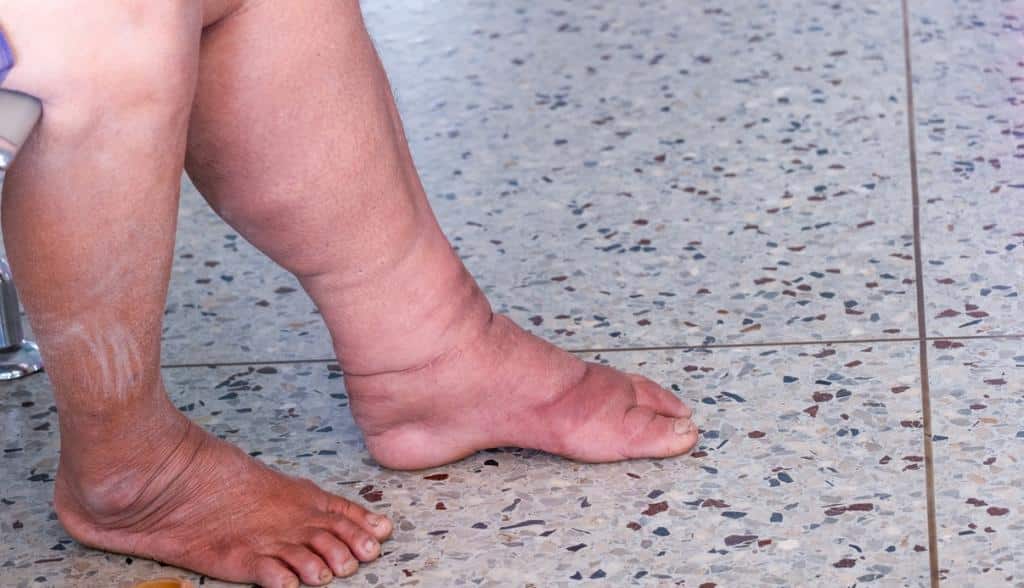About Lymphatic Filariasis
- It is commonly known as elephantiasis and it is a neglected tropical disease.
- Infection occurs when filarial parasites are transmitted to humans through mosquitoes. This impairs the lymphatic system and can lead to the abnormal enlargement of body parts, causing pain, severe disability and social stigma.
- Cause: It is caused by infection with parasites classified as nematodes (roundworms) of the family Filariodidea. There are 3 types of these thread-like filarial worms:
- Wuchereria bancrofti, which is responsible for 90% of the cases.
- Brugia malayi, which causes most of the remainder of the cases.
- Brugia timori, which also causes the disease.
- Symptoms: About two in every three people who have lymphatic filariasis don’t have severe symptoms but filariasis usually leads to a weakened immune system. Some people may experience inflammation, Lymphedema, Hydrocele and Edema.
- Treatment:
- The World Health Organisation recommended preventive chemotherapy strategy for lymphatic filariasis elimination is mass drug administration (MDA).
- MDA involves administering an annual dose of medicines to the entire at-risk population.
- Global Initiatives to Eradicate Lymphatic Filariasis:
- WHO’s road map 2021−2030: Sets global targets and milestones to prevent, control, eliminate or eradicate 20 diseases.
- Global Programme to Eliminate Lymphatic Filariasis (GPELF): WHO established this to stop the transmission of infection by mass drug administration (MDA) of anthelmintics and to alleviate the suffering of people affected by the disease through morbidity management and disability prevention (MMDP).
- According to the WHO progress report on the disease, Nineteen countries have been able to eliminate this disease.
- Of the 19 countries, 11 belong to the WHO Western Pacific Region (WPR). Lao PDR is 11th country in the WPR region to successfully eliminate LF.
- South-East Asia region: Bangladesh, the Maldives, Sri Lanka and Thailand.
- Africa region:Malawi and Togo
Q1) What is parasite
A parasite is an organism that lives on or inside another organism (the host) and derives its nourishment and existence from the host, typically harming the host in the process. Parasitism is a type of symbiotic relationship where one organism benefits (the parasite) at the expense of the other (the host).
Source: Lao PDR becomes second country in 2023 after Bangladesh to eliminate lymphatic filariasis
Last updated on January, 2026
→ Check out the latest UPSC Syllabus 2026 here.
→ Join Vajiram & Ravi’s Interview Guidance Programme for expert help to crack your final UPSC stage.
→ UPSC Mains Result 2025 is now out.
→ UPSC Notification 2026 is scheduled to be released on January 14, 2026.
→ UPSC Calendar 2026 has been released.
→ UPSC Prelims 2026 will be conducted on 24th May, 2026 & UPSC Mains 2026 will be conducted on 21st August 2026.
→ The UPSC Selection Process is of 3 stages-Prelims, Mains and Interview.
→ Prepare effectively with Vajiram & Ravi’s UPSC Prelims Test Series 2026 featuring full-length mock tests, detailed solutions, and performance analysis.
→ Enroll in Vajiram & Ravi’s UPSC Mains Test Series 2026 for structured answer writing practice, expert evaluation, and exam-oriented feedback.
→ Join Vajiram & Ravi’s Best UPSC Mentorship Program for personalized guidance, strategy planning, and one-to-one support from experienced mentors.
→ UPSC Result 2024 is released with latest UPSC Marksheet 2024. Check Now!
→ UPSC Toppers List 2024 is released now. Shakti Dubey is UPSC AIR 1 2024 Topper.
→ Also check Best UPSC Coaching in India

















